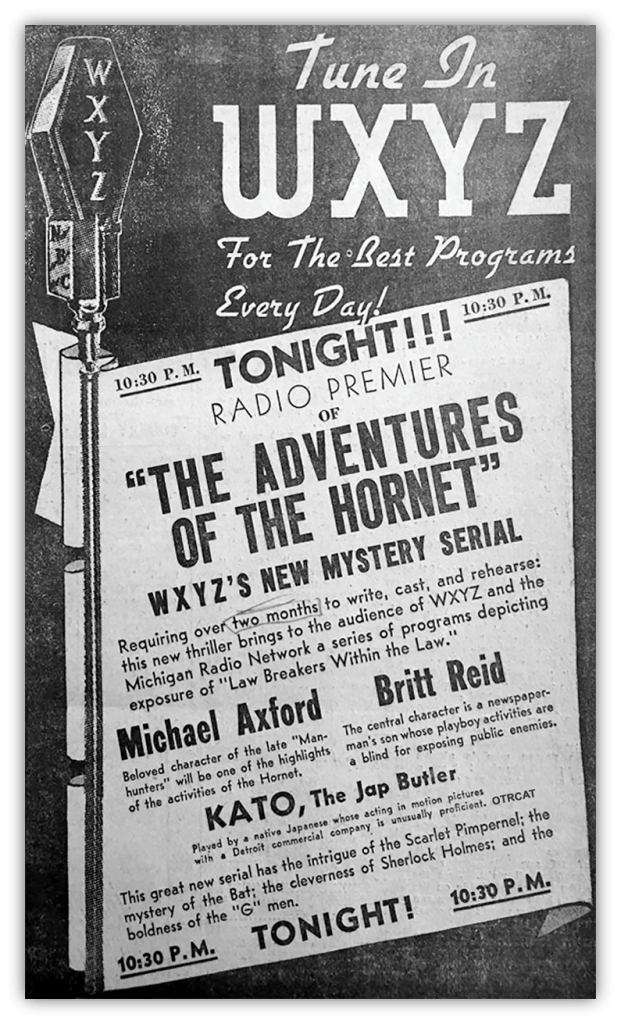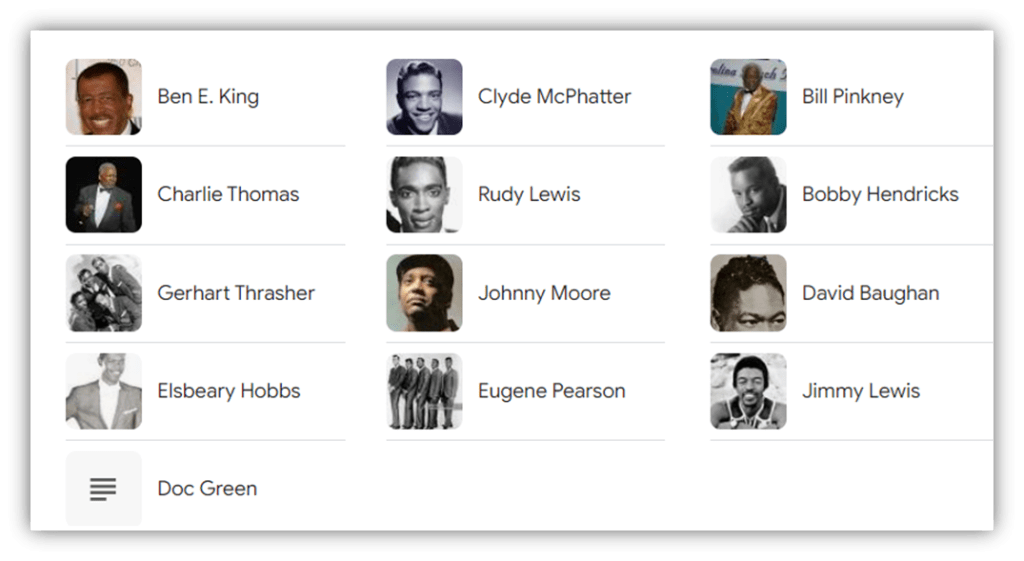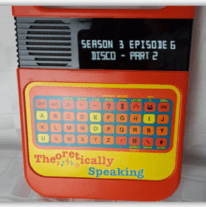The Hottest Hit On The Planet:

“This Ole House“ by Rosemary Clooney
Pop music was in a strange place in the early 50s.
In some ways all the records sounded the same; probably because so many of the records were produced by one man: evil genius, and Head Of Artists & Repertoire for Columbia Records, Mitch Miller.

A man who claimed to have – at one point – been responsible for eight songs in the Billboard Top Ten.
A man who always seemed to choose the corniest ones. The ones that his pop star minions were the surest to hate. The ones he would therefore have to pull rank to defend, threatening to fire his pop star minions if they didn’t do what he said. They all hated him for it, but Mitch didn’t care. Mitch gave them riches, they gave him resentment.

On the other hand, although so many of the records sounded as though they had been infected with the Mitch Miller touch, the songs that Mitch Miller choose, came from some of the most surprising places.
Other songs on the charts by Mitch’s minions this time 70 Years Ago include “Skokiaan”, a Zimbabwean song originally recorded by The African Dance Band of the Cold Storage Commission of Southern Rhodesia, as recorded in this case by the Canadian barbershop quartet, The Four Lads.
Despite its African origins, Mitch still managed to make it sound like the whitest record you will ever hear.
The Four Lads had only recently had a hit with the faux-German parody “Gilly Gilly Ossenfeffer Katzenellen Bogen by the Sea.” Basically, my point is, that Mitch Miller took his hit songs from all over the place.
Pop songs, country songs, quirky foreign jingles: it was all the same to him.
In the case of “This Ole House” the song came from a “singing cowboy”. A “singing cowboy” named Stuart Hamblen.
Whether on radio, or in a Hollywood movie, “singing cowboys” were a whole thing. Many found the mere sight of a cowboy moseying his way through a canyon on his horse, singing a lonesome tune, maybe doing some lonesome yodelling, to be irresistible.

Stuart Hamblen was such a popular “singing cowboy” that he made evangelist preacher Billy Graham the most popular evangelist preacher in America.
Billy, you see, had cured Stuart of his alcoholism. So total was Stuart’s denouncement of alcohol that he refused to do any more beer commercials and was consequently fired from his “singing cowboy” radio job. But he still had his fellow “singing cowboy” friends, one of which was John Wayne. Together they went hunting together. And together, whilst hunting, they came across an old house.
Inside of this old house was a dead man.

“This Old House”, the Stuart version – and just to be clear, the Stuart version is spelt “old” – are the imagined last words of the dead man, looking back over his life and his wife and the life and the house that they shared.
This is made obvious by the sounds of ghosts on the intro. At least I assume they are supposed to be ghosts. It may be the cold wind blowing through the cracks in the wall.
His grisly death is also made clear by the lyrics: the reason the dying man ain’t gonna need the house no longer is because he’s getting ready to meet the saints. This old house is falling apart in the original Stuart version, but not comically so. In the original Stuart version, the old man’s death is the punch line. Dying means that he no longer has to DIY.
Pop radio in the 50s wasn’t about to play a record about death between advertisements for Pontiacs, cigars and liver pills.
For Rosemary’s pop version it’s the house itself that’s the main character:

A good-for-nothin’ house, an anthropomorphic cartoon house that’s afraid of thunder, and afraid of storms.
Lyrically the differences are few. Just enough to switch the song from being in the first person to being in the second, just enough to prevent Rosemary from having to play the role of a dying man – but the impact is huge.
Intentionally or not, in “This Ole House” (Rosemary Clooney’s Version) it’s the house that is going to die. It’s shingles and window frames are going collapse as soon as the song ends. What more could you expect from such a good-for-nothin’ house?
Rosemary may have had her name on the label. But who really steals the show is whoever the hell that is with the baritone! Well I’m hear to tell you who that is with the baritone… it’s – as if this song could not get any more cartoonish:

Tony The Tiger!
Actual name, Thurl Ravenscroft!

He’s GRREEEEEAAAATTTTTT!!!!!
Rosemary Clooney had sung a song about a house before. It wasn’t that she particularly liked houses. It wasn’t as though she’d always dreamt of being an architect or anything. It wasn’t that she liked singing songs about houses. It was because Mitch Miller liked her singing songs about houses.
Or because Mitch Miller realized that a stupid, annoying song about a house would always sell loads and loads, particularly if it were sung in a foreign accent. This is why Rosemary Clooney ended up singing “Come On-A My House” in the style of an Italian-mama.
She doesn’t do it in that performance, but she usually finished the song off with “that’s a-nice!!”
Once “Come On-A My House” became a hit, Mitch gave her more faux-Italian songs. “Botch-A-Me” for example. Another which will come up in a few months. Rosemary’s Italian accent wasn’t even all that good, which shouldn’t have been a surprise since she was Irish-German.
That it’s an Italian accent and not… I dunno, Mexican? Scottish? Chinese? Jamaican? Indian? You’re trying to imagine all of these now, aren’t you?… is at least partially Rosemary’s fault. Mitch told her she had to do in “an” accent, he was less concerned what the accent was. Italian was the only accent that Rosemary “knew.”
At least that’s one version of events. Other sources say that Mitch had a very specific accent in mind: Armenian.

“Come On-A My House” was written by two Armenian-Americans, and was an adaptation of an Armenian folk song, so there’s probably something in that.
But Rosemary had no idea of what an Armenian accent sounds like, so that wasn’t going to work. Italian was the best she could do.
Even when not forcing her to put on an Italian accent upon pain of dismissal, Mitch was forcing Rosemary to sing silly songs, using his evil genius production techniques – he was a big fan of including some boogie-woogie harpsichord for some reason – to make them sound even sillier.
This is why, in virtually every piece of Rosemary Clooney footage you will see, Rosemary is wearing the forced smile and pained impression of a woman remembering that time Mitch talked her into doing a duet with Jimmy Boyd – the “I Saw Mommy Kissing Santa Claus” kid – about “Dennis The Menace.”
“This Ole House” is a 7.
Meanwhile, in R&B Land:

“Honey Love” by The Drifters
The last time we visited the 50s, we discussed a whole bunch of R&B records that were “banned” for being too lewd. I’m putting the word “banned” in inverted commas, because we aren’t talking about, like, a nationwide ban or anything. Even the 1950s weren’t that bad. Still, for a kid in Memphis, Houston, or Detroit, being deprived of hearing “Honey Love” by The Drifters, must have felt pretty bad.
For “Honey Love” by The Drifters was banned from nine Houston radio stations, as well as every jukebox and record store within the Houston City Limits:

As a result of the Juvenile Delinquency and Crime Commission, and specifically its “Wash Out The Air” subcommittee.
And “Honey Love” was a record deemed so dirty by the Memphis policy that they confiscated every copy the moment they arrived in town, before it had the chance to contaminate the jukebox machines and the morals of the kids who used them.
I’m not sure if “Honey Love” was banned in Detroit, but another Drifters record was. We’ll get to that.
It’s honestly difficult to figure out what about “Honey Love” that the Memphis police found objectionable.

Clyde (McPhatter, chief Drifter at the time) needs it, when the moon is bright. He needs it, when you hold him tight. He needs it, in the middle of the night. He needs your… *pause for effect* honey love.
The concern, apparently, was over the use of the word “it”, and what “it” could possibly mean.
I mean, obviously “it” means “sex.” And her “honey love” means sex. I get that. But Clyde doesn’t even sing “it” suggestively. Not really. There are a couple of moments towards the end where he goes “mmm” in a manner that’s perhaps a little bit sexual, but even future Drifters’ lead singer, Ben E. King, sounded hornier whenever he went “mmm”, and Ben E.’s “mmmm”s – of which there were a lot! – were amongst the most chaste in pop!
Perhaps the Memphis Police were just being extra careful following the reputation of Clyde’s previous group, Billy Ward and The Dominos. Which Clyde had recently quit, finding it odd that he was singing on big hit records, but did not have enough money to even buy a Coke – most notably their hit “Sixty Minute Man” (it’s a 10).
Clyde hadn’t been the one singing the more suggestive lyrics on “Sixty Minute Man”, he was just doing some high-pitched backing vocals.

Whilst Billy Ward’s performance on “Sixty Minute Man” is knowingly and deliberately lascivious…
…Clyde’s mode of seduction was to sound playful and innocent. He played it cute, with cute songs and cuter titles. You would think that he’d have been able to get away with it.
But apparently not.
It feels as though virtually every record from this early Clyde McPhatter era of The Drifters got banned somewhere in America. Having their records banned seems to have been an occupational hazard for The Drifters. They may have been the least controversial looking, the least controversial sounding, controversial band of all time!

I mean, The Drifters started off as Clyde McPhatter and his friends from the Lebanon Singers of 132nd Street Mount Lebanon Church in Harlem.
Sure, he soon had to dump them because they were rubbish, and get another bunch of singers, but they were all gospel singers too! The Drifters do not come-across as a bunch of kids out to corrupt the morals of American youth!!
The Drifters’ previous single “Such A Night” had also gotten banned. This time in Detroit. By radio station WXYZ. They claimed to be “The Last Word In Radio” (Get it?)

WXYZ seemed to have been something of a kid’s radio station, judging by the fact that they were the original producers of both The Lone Ranger and The Green Hornet, so a certain amount of prudishness should probably have been expected.
They even banned the quite excellent Johnnie Ray version. So apparently did the BBC over in the UK. The Drifters version didn’t get a release in the UK, but they probably would have banned that version as well. Actually, come to think of it, being a ”white” radio station WXYZ probably weren’t planning to play The Drifters’ version anyway.

I’m feeling kind of guilty not using the opportunity to feature Johnnie Ray when “Such A Night” reached No.1 in the UK – it may have been banned by the BBC but all the kids were listening to Radio Luxemburg – back in May.
A gay man, wearing a conspicuous hearing aid, with the ability to cry on demand, singing a party song about a one-night stand, a few years after getting arrested for attempting to solicit a one-night stand from an undercover police officer in, oh look at that, Detroit.
Coincidence? Who can say? That would have been such an article! Such a performance! “Such A Night”!
Almost as soon as “Honey Love” hit, Clyde was called up to join the U.S. Special Forces. In terms of career momentum this wasn’t exactly disastrous, since he was never sent abroad. He was only sent to Buffalo. He could come down to play in New York on the weekends.
Once he was discharged from the Army however, Clyde decided to go solo, becoming one of the most popular R&B singers of the late 50s.
The Drifters just found a new lead singer and kept going. Finding new lead singers and just keeping on going would be a hugely successful strategy for The Drifters. They would eventually go through twelve of them.

The Drifters would go through so many lead singers that they sometimes seemed to double-up, twice having a lead singer by the name of Charlie Thomas.
Despite both Charlie Thomases coming from Virginia, and despite having previously known each other, they were in fact two completely different Charlie Thomases!
I’m sure I’ll have an opportunity to write about them again.
“Honey Love” is an 8
Meanwhile, in Cool Jazz Land:

“Misty” by the Erroll Garner Trio
You know “Misty” of course.
But before there was “Misty” the song, there was “Misty” the instrumental piano piece. Written by Erroll Garner on a flight from San Francisco to Chicago. They’d just flown through a storm, a stressful experience for all involved, but that had passed and now there was a rainbow in the sky. And misty dew drops on the window. And a tune in Erroll’s head.
Erroll didn’t have a piano handy – he was after all, on a plane, and sure it was the Golden Age Of Air Travel, but even back then they couldn’t just wheel a piano down the aisle for you – so Erroll played his knees and hummed to himself.

Naturally his fellow passenger – a little old lady – thought he was sick and called a hostess over. Presumedly by “sick” she meant “a little bit funny in the head.”
But you need to be “a little bit funny in the head” to write a tune like “Misty”, and certainly to play a tune like “Misty” the way that Erroll plays it.
The amazing thing about “Misty”, at least the way that Erroll plays it, is:

No matter how much he diverts from the sheet music – not that there would have been sheet music, since he couldn’t read it – no matter how many runs he adds, no matter even if he stops playing all together creating an awkward second of suspended silence, the melody still runs all the way through.
This is the way jazz is supposed to work, but sadly, only very rarely does.
Jazz piano always sounds more impressive when you are watching it, watching fingers do so many things so quickly, that it ought to be physically impossible, so here’s that. I wonder if that’s how he played it on the plane? No wonder the little old lady thought he was crazy.
Just how this pretty piece of piano became a jazz, a pop, and even a novelty country standard, is a long story.
Weirdly enough, we probably have to thank Mitch Miller. For Erroll recorded for Columbia. He seems to have recorded for virtually everyone. A Black jazz pianist recording for Columbia was a bit of a rarity at the time.
Sure they had Duke Ellington, but the Duke was operating at a whole other level – so Erroll was selling a whole lot more than his contemporaries like Bud Powell or Thelonious Monk – a live album the next year would sell over a million copies! – even if the album titles didn’t really sound all that appealing.

Who thought that an album titled “Music For Tired Lovers” would be a hit?
Since Mitch Miller was basically ruling Columbia Records at the time, and consequently had his own orchestra, it was only a matter of time before Mitch decided to invite Erroll in for a syrupy symphonic session.
And a couple of years later, Johnny Mathis was racing up the charts with his version.
Now, Johnny Mathis had already heard “Misty.”

He had already gone up to Erroll after a show, in a jazz bar in San Francisco, before “Misty” even had lyrics. And he promised Erroll, if he ever became a pop star, that one day he would record it.
But surely having your producer – Mitch – previously produce a version, and one of similar sweetness, why, that’s just kismet! Even better, what with belonging to the same record company and all, Erroll just happened to be wandering by.
And he wandered in. It must be weird to hear a song that you wrote, becoming a pop standard.

Particularly when you wrote that song playing an imaginary piano on your lap, whilst sitting on a plane, whilst sitting next to an old lady who probably thought you were crazy.
“Misty” (the Erroll Garner Original) is a 9.
So’s Johnny’s version, for that matter.

Let the author know that you liked their article with a “Green Thumb” Upvote!





Music For Tired Lovers raises questions. Are they tired because they’ve been doing ‘it’? Tired from fixing up the house? Tired of each other? The album cover suggests the latter, only one of those lovers looks like physical exertion is too much for them. The other has a look that suggests she wants to trade him in for a younger model that can keep up with ‘it’.
I’ve never heard Rosemary’s version of This Ole House. Over here there can only be one version that comes to mind. The Welsh Elvis himself; Shakin’ Stevens (real name Michael Barratt) getting the first of 4 UK number ones in 1981. No expense spent on the video. Shakey’s double denim probably cost more. And just look at those moves, he seemed a lot cooler when I was 5. Not so much a steaming sex symbol, more a man with ants in his pants trying to shake them loose. The only threat Shakey offered to the nations youth was by copying his death defying (ahem) leaps from a first floor window.
They don’t make them like this anymore.
https://youtu.be/dRvcrWGUmR4?feature=shared
Just a year before Songs for Tired Lovers was Frank Sinatra’s Songs for Young Lovers album. The next year Frank came out with Songs for Swingin’ Lovers! I think that they were just poking fun at those album titles categorizing music for certain types of lovers. It’s all very silly.
Hang on… given the well-known antagonism between Frank and Mitch are you telling me they were engaging in the 1950s version of a hip-hop diss-track war, via the medium of snarky album titles?
Hilarious if true!
You’re thoughts on Music for Tired Lovers had me smiling. Of course my first thought was “how many thrift stores will I have to go to in order to find said album”? Must have it.
I always like the 1954 reviews, Dan. “Misty” is a great standand. It sounds good no matter who is singing it (within reason). I wasn’t sure if I would know Errol’s original, but I did. Probably from when I used to listen to an easy listening station back in the 1990s. Despite how much hate Ray Stevens gets, I think most people would even have to admit that his peppy country version from 1975 is darned good.
Rosemary Clooney isn’t my favorite from that era, but I don’t know if that is her fault or the fault of those choosing songs for her. I mean, I’m all for novelty songs of the 50s, but some of hers really don’t resonate. That “Dennis the Menace” song was really pretty bad! Never heard that one before.
Keep up the good work!
When you say “within reason”, I would assume that would not include this guy- https://www.youtube.com/watch?v=ljiVRV5B5i8
It’s a sign of a good song when it can be done in various interpretations and still be good. From Errol Garner to Ray Stevens, “Misty” is a great song.
I think I mentioned Dakota Staton here recently. I love her version of it. What a voice.
https://youtu.be/G-7ls9l1_8E
The Late, Late Show is a great album from start to finish.
To say that “Misty” is my favorite Ray Stevens record sounds like damning with faint praise … so let me add that it’s among my top 100 of 1975.
I love stories about songs being composed in one’s head, somewhere that didn’t allow for it to be written down or fleshed out on an instrument, like Errol Garner and “Misty”. I remember hearing years ago at an outdoor band concert that John Philip Sousa wrote “The Stars and Stripes Forever” while on a ship. He heard a band playing it in his head, with all of the various parts and everything, and just put it to paper when he got home. Amazing how the mind can work.
Also, Thurl Ravenscroft has come up here before, and is somewhat of a hero to me and probably some other folks around here, for a song he recorded for a certain legendary Christmas animated feature. He walks amongst the immortals for this.
If vails were a TNOCS.com visitor (where are you vails??), he would certainly chime in. He loves Thurl.
My favorite Thurl Ravenscroft is this old sea shanty
https://www.youtube.com/watch?v=eg8vlK_BJas